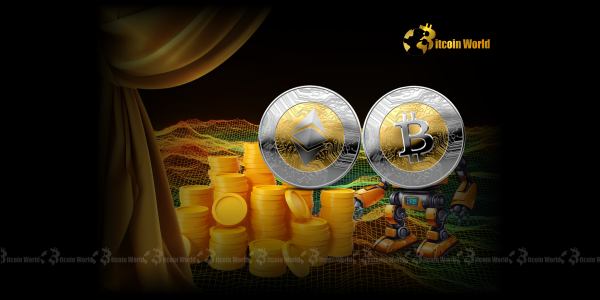Binance Proof of Reserves: Unveiling Crucial Shifts in BTC and ETH Holdings
0
0

In the dynamic and often unpredictable world of cryptocurrencies, trust is the ultimate currency. For millions of users worldwide, knowing that their digital assets are secure and verifiable is paramount. This is precisely why initiatives like Proof of Reserves (POR) have become a cornerstone for major exchanges. Binance, one of the largest cryptocurrency exchanges globally, consistently publishes its Proof of Reserves reports, offering a crucial glimpse into its financial health and the composition of its user funds. Their latest report, based on a July 1 snapshot, has unveiled some fascinating and perhaps unexpected shifts in asset distribution, particularly concerning BTC holdings, ETH holdings, and a notable increase in USDT holdings. What do these changes truly signify for the broader market and for your crypto portfolio?
Understanding Binance Proof of Reserves: A Cornerstone of Trust
Before we dive into the specifics of the latest report, it’s essential to grasp what a Proof of Reserves report entails and why it’s so vital in the cryptocurrency ecosystem. In essence, a Proof of Reserves is an independent audit that verifies a cryptocurrency exchange holds the assets it claims to on behalf of its users. This process typically involves cryptographic proofs, like Merkle Trees, to allow individual users to verify their own funds are included in the total reserves without revealing their personal information.
The importance of POR was starkly highlighted in the wake of significant industry events, particularly the collapse of FTX. These incidents underscored the critical need for exchanges to demonstrate solvency and transparency. By regularly publishing these reports, Binance aims to foster greater confidence among its user base, showing that customer funds are indeed backed 1:1 and are not being used for undisclosed purposes. It’s a proactive step towards building a more transparent and accountable financial system, setting a benchmark for crypto transparency across the industry.
Crucial Shifts: Diving Deep into Binance’s BTC Holdings and ETH Holdings
The 32nd Proof of Reserves report from Binance, based on a snapshot taken on July 1, provides a detailed look at the exchange’s reserves. The figures, as reported by Wu Blockchain on X, indicate a noticeable recalibration of assets held on the platform. Let’s break down the key changes:
- Bitcoin (BTC) Holdings: User BTC holdings stood at 573,000. This represents a decline of 3.27% compared to the figures from June.
- Ethereum (ETH) Holdings: User ETH holdings also saw a decrease, falling by 5.34% to 5.051 million.
These declines in two of the largest and most prominent cryptocurrencies on the platform raise important questions. What factors could be contributing to this shift? Several possibilities come to mind:
- User Withdrawals and Self-Custody: A common trend in the crypto space, especially after market turbulence, is for users to move their assets off exchanges and into self-custody solutions (like hardware wallets). This is often driven by a desire for greater control and security, aligning with the core ethos of decentralization.
- Market Volatility and De-risking: The crypto market is known for its volatility. Users might be reducing their exposure to more volatile assets like Bitcoin and Ethereum, opting to hold less on exchanges or rebalancing their portfolios in response to market conditions.
- Profit-Taking or Reallocation: Users might be selling off portions of their BTC and ETH holdings, either to realize profits or to reallocate funds into other assets or investment opportunities outside of the Binance ecosystem.
It’s important to note that a decline in exchange BTC holdings or ETH holdings doesn’t necessarily indicate a lack of confidence in the assets themselves, but rather a shift in where users prefer to hold them or how they are managing their risk exposure.
The Rising Tide: Exploring the Implications of Increased USDT Holdings
While Bitcoin and Ethereum saw declines, the report highlighted a significant increase in Tether (USDT) holdings:
- Tether (USDT) Holdings: User USDT holdings rose by 2.64% to an impressive 29.59 billion.
This increase in stablecoin holdings is particularly noteworthy and can be interpreted in several ways, each shedding light on current market sentiment and user behavior:
- Flight to Safety: During periods of market uncertainty or volatility, stablecoins like USDT often serve as a safe haven. Users might be converting their more volatile assets into stablecoins to preserve capital, effectively waiting out potential downturns without exiting the crypto market entirely.
- Preparation for Trading Opportunities: An increase in stablecoin reserves on an exchange can also indicate that users are positioning themselves for future trading opportunities. Having readily available USDT allows traders to quickly enter new positions when they identify favorable market conditions or dips in asset prices.
- Increased Trading Activity: USDT is a primary trading pair for a vast number of cryptocurrencies. Higher USDT holdings on the exchange could also reflect an increase in overall trading activity or liquidity being held for various trading strategies.
- Yield Opportunities: Some users might be holding USDT on the exchange to participate in staking, lending, or other yield-generating opportunities offered by Binance or integrated DeFi protocols.
The rise in USDT holdings suggests a strategic decision by users to maintain liquidity and stability within the exchange environment, whether for defensive purposes or to capitalize on future market movements.
Why Crypto Transparency Matters: Beyond Just Numbers
The significance of Binance’s Proof of Reserves reports extends far beyond just the fluctuating numbers of specific cryptocurrencies. These reports are foundational to building trust and legitimacy in the nascent crypto industry. Here’s why crypto transparency is more critical than ever:
- Restoring Confidence: In an industry that has faced its share of scandals and collapses, transparent reporting helps restore and maintain user confidence. It assures users that their funds are not being mismanaged or used for undisclosed purposes.
- Reducing Systemic Risk: By regularly verifying reserves, exchanges contribute to reducing systemic risk within the broader crypto ecosystem. It prevents situations where exchanges operate with fractional reserves, which can lead to widespread financial instability.
- Setting Industry Standards: Major exchanges like Binance, by committing to regular POR, set a precedent for others in the industry. This encourages a culture of accountability and pushes for higher operational standards across the board.
- Regulatory Acceptance: As regulators worldwide grapple with how to oversee the crypto space, transparent reporting mechanisms like POR can play a crucial role. They provide regulators with verifiable data, potentially paving the way for more favorable regulatory frameworks and mainstream adoption.
- Empowering Users: Ultimately, transparency empowers users. It gives them the information needed to make informed decisions about where to store their assets and which platforms to trust.
These reports are not just compliance checkboxes; they are vital tools for fostering a healthy, sustainable, and trustworthy digital asset economy.
Navigating the Nuances: Challenges and What These Binance Proof of Reserves Reports Don’t Tell Us
While Proof of Reserves reports are a monumental step forward for crypto transparency, it’s also important to approach them with a nuanced understanding of their limitations. No single report can paint a complete picture, and there are aspects that these snapshots typically don’t fully address:
- Snapshot in Time: A POR report is just that—a snapshot. It reflects the exchange’s reserves at a specific moment. The composition of assets can change rapidly, sometimes within hours or minutes, due to high trading volumes and user activity. It doesn’t provide a real-time, continuous audit.
- Liabilities Side: While POR verifies the assets held by the exchange, it often provides less detail about the exchange’s liabilities (what it owes to users). A true, comprehensive audit would involve both proof of assets and proof of liabilities to ensure full solvency. Exchanges like Binance have made strides in this area by integrating Merkle Tree proofs for user verification, but the full picture of liabilities can still be complex.
- Off-Chain Assets: POR typically focuses on on-chain assets. However, exchanges may hold some assets in off-chain or cold storage solutions, which are harder to verify cryptographically in a public report.
- Scope of Assets: Not all assets listed on an exchange may be included in the POR. While major cryptocurrencies like Bitcoin, Ethereum, and stablecoins are usually covered, smaller altcoins might not always be.
- Reliance on Auditor: While the process involves cryptographic verification, there’s still an element of trust placed in the third-party auditor or the exchange’s internal processes for generating and presenting the data.
Understanding these limitations is crucial for users to maintain a healthy skepticism and to complement their reliance on POR with other due diligence practices.
Actionable Insights for Users: What to Do with This Information?
So, what should you, as a cryptocurrency user, take away from Binance’s latest Proof of Reserves report and the broader discussion around crypto transparency? Here are some actionable insights:
- Stay Informed: Regularly review POR reports from exchanges you use. While they are snapshots, consistent positive reports over time can build confidence. Pay attention to trends in BTC holdings, ETH holdings, and USDT holdings.
- Consider Self-Custody: For long-term holdings, especially significant amounts, consider moving your assets to a hardware wallet or other self-custody solutions. This gives you direct control over your private keys, reducing reliance on any third-party exchange.
- Diversify Your Holdings: The shifts seen in Binance’s report underscore the dynamic nature of crypto assets. Diversifying your portfolio across different assets and potentially different trusted platforms can mitigate risk.
- Understand Market Sentiment: Changes in exchange holdings can be a good indicator of broader market sentiment. An increase in stablecoins, for instance, might suggest caution among traders, while an increase in volatile assets could signal growing bullishness.
- Do Your Own Research (DYOR): Never solely rely on a single report or news piece. Combine information from POR reports with broader market analysis, news from reputable sources, and your own risk assessment before making financial decisions.
The Future of Trust: What’s Next for Crypto Transparency?
Binance’s consistent efforts with its Proof of Reserves reports represent a significant step in the ongoing journey towards greater crypto transparency. The latest report, revealing a fascinating redistribution of BTC holdings, ETH holdings, and a surge in USDT holdings, offers valuable insights into user behavior and market dynamics.
As the industry matures, we can expect to see further innovations in transparency and auditing methods. The goal is to move towards real-time, comprehensive, and fully verifiable systems that leave no room for doubt regarding the solvency and integrity of crypto exchanges. Binance, by continuing to publish these crucial reports, plays a pivotal role in setting the standard and guiding the industry towards a more trustworthy and resilient future.
A Vital Snapshot: Summarizing Binance’s Asset Evolution
In conclusion, Binance’s 32nd Proof of Reserves report offers a compelling snapshot of evolving asset preferences and market sentiment within its user base. The decline in BTC holdings and ETH holdings, juxtaposed with the rise in USDT holdings, paints a picture of users potentially de-risking, seeking stability, or positioning for future opportunities. This report not only reinforces Binance’s commitment to transparency but also provides valuable data for anyone navigating the complex crypto landscape. As the industry continues to mature, such detailed insights into exchange reserves will remain indispensable for fostering trust and empowering informed decisions.
To learn more about the latest crypto market trends, explore our article on key developments shaping Bitcoin and Ethereum price action.
0
0
 Manage all your crypto, NFT and DeFi from one place
Manage all your crypto, NFT and DeFi from one placeSecurely connect the portfolio you’re using to start.







